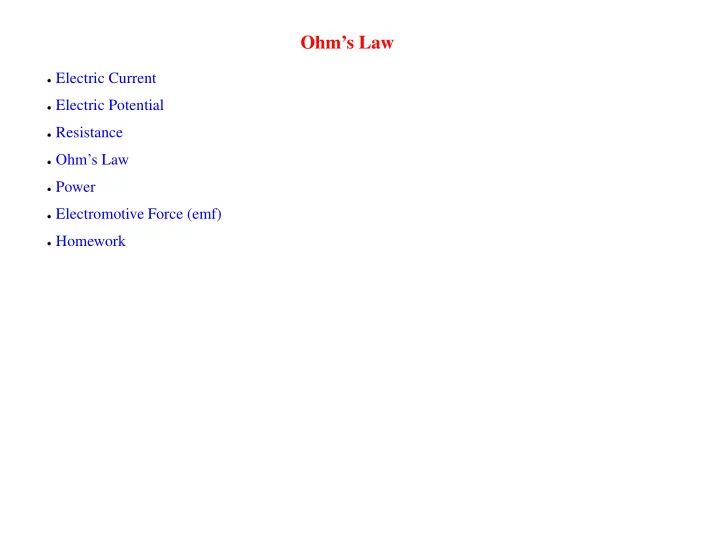

� � � � � � � Ohm’s Law Electric Current Electric Potential Resistance Ohm’s Law Power Electromotive Force (emf) Homework
☎ ✁ ✞ ✆ ✝ � ✝ ✂ ✠ ✂ ✄✆ ☎ ✄ ✂ ✁ � ✞✟ Electric Current Electric current is defined as the net rate of flow of charge through a cross-section of a conductor – For constant current – The unit of current is the ampere (A) ✡☞☛ From conservation of charge – I is the same in any cross-section of the conductor – analogous to water flow in a pipe
✗ ✌ ✗ � ✌ ✍ ✎ ✝ ✘ ✂ ✘ ✒ ✌ ✘ ✑ ✂ ✏ � ✑✒ ✂ ✌ ☎ ✓ ✒ ✑ ✌ ✍ ✎ ✕ ✄ ✌ ✍ ✍ ✌ ✄ ✌ ✌ ✍ ✎ � ✌ ✍ ✎ ✏ ✑✒ ✂ ✓ ✒ ✑ ✍ ✓ ✍ ✌ ✑ ✒ ☎ ✂ ✗ ✍ ✌ ✄ Electric Potential Consider a charge q moving from point A to point B in an electric field The work done by as q moves from A to B is ✔✖✕ ✎✖✕ The change in potential energy is defined to be the negative of the work done by
✌ ✒ ✂ ✙ ✞ ✡ � ✗ ✍ ✌ ✄ ✕ ✎ ✍ ✠ ✑ ✓ ✚ ✌ � ✝ ✙ ✂ ✙ ✒ ✙ ✌ ✑ ✂ ✝ ✘ ☎ ✂ ✞ Electric Potential (cont’d) The potential difference between points A and B is defined as the change in potential energy per unit charge The unit of electric potential is the volt (V) We often set a reference point, called ground, to have an electric potential of zero volts and then determine the electric potential at all other points relative to this reference point
✜ ✞ � ✟ ✛ ✂ ✝ ✙ ✁ � ✡ � ✙ ✞ ✜ ✂ Resistance and Ohm’s Law The resistance of a conductor is defined as the ratio of the potential difference across the conductor to the current flowing through it The unit of resistance is the ohm ( ) For many materials, the resistance is constant over a wide range of applied voltages and this behavior is known as Ohm’s law
✂ ✢ ✜ ✢ ✣ ✟ ✟ ✛ � ✣ Resistivity For a conductor of length and cross-sectional area the resistance is where is the resistivity of the material (units: m)
✛ ✙ ✘ ✄✆ ✂ ✙ ✁ ✤ ✂ ✁ � � ✤ ✂ ✛ ✂ ✝ ✙ ✥ ✄ ✆ ✄ ✂ ✄ ☎ ✝ ✙ ✁ ✘ ✄ ✝ ✙ ✄ ☎ ✂ ✝ ✙ Power The electric potential energy converted to heat by a charge moving through a potential differ- ence is If the material is ohmic (resistor) ✁✦✥
✁ ✄ ✧ ✂ ✆ ✄ ☎ ✄ ✕ ☎ ✄ ✏ ✄ ✂ ✄✆ ✏ � � ✄ � ✧ ✂ ✏ ✄ ☎ � � Electromagnetic Force (emf) Any device that increases the potential energy of a circuit by maintaining a potential difference between points in a circuit while charges move through the circuit is called a source of electro- motive force (emf) The emf is defined as the work done per unit charge by the device An ideal emf device is one that lacks any internal resistance Any real emf device, such as a battery, has internal resistance The rate at which energy is delivered by the emf is
✗ ✁ ✁ ✌ ✧ ✂ ✙ ✝ � ✗ ★ ✛ ✧ ✂ ✁ ✛ ★ � ✗ ✧ ✁ ✂ ✁ ✗ ✥ ★ ✛ ✧ ✂ ✁ emf (cont’d) From conservation of energy, the rate at which electric energy is delivered by the emf is equal to the rate at which electric energy is converted to heat in the resistances of the circuit shown below ✁✦✥ The terminal voltage of the battery is
✜ ✜ ✧ ✩ ✜ ✧ ✥ ✥ ✩ Example The circuit elements in the circuit below have the following values: = 4.4 V, = 2.1 V, r = 2.3 , r = 1.8 , and R = 5.5 . (a) What is the current I in the circuit? (b) What is the potential difference between the terminals of battery 1? ε ε I 1 2 Battery 1 Battery 2 r 1 r 2 I R
� � � Homework Set 12 - Due Wed. Feb. 11 Read Sections 21.1 - 21.6 Answer Questions 21.3, 21.5, & 21.10 Do Problems 21.9, 21.15 & 21.23
Recommend
More recommend